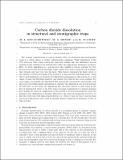| dc.contributor.author | Hesse, M. A. | |
| dc.contributor.author | Szulczewski, Michael L. | |
| dc.contributor.author | Juanes, Ruben | |
| dc.date.accessioned | 2015-01-09T14:49:14Z | |
| dc.date.available | 2015-01-09T14:49:14Z | |
| dc.date.issued | 2013-11 | |
| dc.date.submitted | 2013-09 | |
| dc.identifier.issn | 0022-1120 | |
| dc.identifier.issn | 1469-7645 | |
| dc.identifier.uri | http://hdl.handle.net/1721.1/92755 | |
| dc.description.abstract | The geologic sequestration of carbon dioxide (CO[subscript 2]) in structural and stratigraphic traps is a viable option to reduce anthropogenic emissions. While dissolution of the CO[subscript 2] stored in these traps reduces the long-term leakage risk, the dissolution process remains poorly understood in systems that reflect the appropriate subsurface geometry. Here, we study dissolution in a porous layer that exhibits a feature relevant for CO[subscript 2] storage in structural and stratigraphic traps: a finite CO[subscript 2] source along the top boundary that extends only part way into the layer. This feature represents the finite extent of the interface between free-phase CO[subscript 2] pooled in a trap and the underlying brine. Using theory and simulations, we describe the dissolution mechanisms in this system for a wide range of times and Rayleigh numbers, and classify the behaviour into seven regimes. For each regime, we quantify the dissolution flux numerically and model it analytically, with the goal of providing simple expressions to estimate the dissolution rate in real systems. We find that, at late times, the dissolution flux decreases relative to early times as the flow of unsaturated water to the CO[subscript 2] source becomes constrained by a lateral exchange flow though the reservoir. Application of the models to several representative reservoirs indicates that dissolution is strongly affected by the reservoir properties; however, we find that reservoirs with high permeabilities (k ≥ 1 Darcy) that are tens of metres thick and several kilometres wide could potentially dissolve hundreds of megatons of CO[subscript 2] in tens of years. | en_US |
| dc.description.sponsorship | United States. Dept. of Energy (Grant DE-SC0003907) | en_US |
| dc.description.sponsorship | United States. Dept. of Energy (Grant DE-FE0002041) | en_US |
| dc.description.sponsorship | MIT Masdar Program | en_US |
| dc.description.sponsorship | Martin Family Fellowship for Sustainability | en_US |
| dc.language.iso | en_US | |
| dc.publisher | Cambridge University Press | en_US |
| dc.relation.isversionof | http://dx.doi.org/10.1017/jfm.2013.511 | en_US |
| dc.rights | Creative Commons Attribution-Noncommercial-Share Alike | en_US |
| dc.rights.uri | http://creativecommons.org/licenses/by-nc-sa/4.0/ | en_US |
| dc.source | Anne Graham | en_US |
| dc.title | Carbon dioxide dissolution in structural and stratigraphic traps | en_US |
| dc.type | Article | en_US |
| dc.identifier.citation | Szulczewski, M. L., M. A. Hesse, and R. Juanes. “Carbon Dioxide Dissolution in Structural and Stratigraphic Traps.” J. Fluid Mech. 736 (November 6, 2013): 287–315. | en_US |
| dc.contributor.department | Massachusetts Institute of Technology. Department of Civil and Environmental Engineering | en_US |
| dc.contributor.approver | Juanes, Ruben | en_US |
| dc.contributor.mitauthor | Szulczewski, Michael L. | en_US |
| dc.contributor.mitauthor | Juanes, Ruben | en_US |
| dc.relation.journal | Journal of Fluid Mechanics | en_US |
| dc.eprint.version | Original manuscript | en_US |
| dc.type.uri | http://purl.org/eprint/type/JournalArticle | en_US |
| eprint.status | http://purl.org/eprint/status/NonPeerReviewed | en_US |
| dspace.orderedauthors | Szulczewski, M. L.; Hesse, M. A.; Juanes, R. | en_US |
| dc.identifier.orcid | https://orcid.org/0000-0002-7370-2332 | |
| mit.license | OPEN_ACCESS_POLICY | en_US |
| mit.metadata.status | Complete | |
